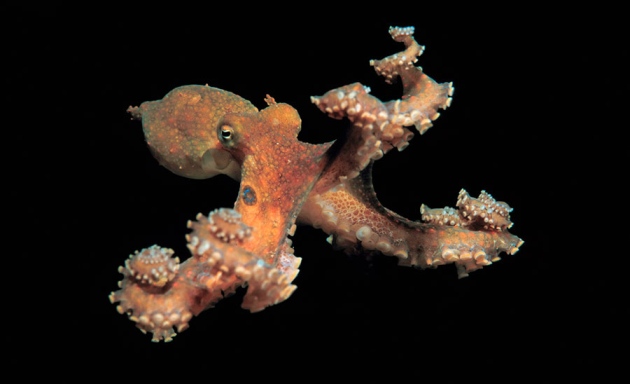

Image taken from the following Nature News report (Abbott 2015) (Author permission pending)
Research spearheaded by a team at the University of Chicago set out to fully sequence the genome of the California two-spot octopus (Octopus bimaculoides) for the very first time. The octopus has long garnered attention for its incredible structural and neural complexity relative to related mollusks (clams, squid, etc.). By fully sequencing the genome in addition the transcriptome (all RNA molecules produced from the genome), it is possible to answer questions long posed by researchers in the field, such as whether the neural and structural complexity of octopuses is due to a genome duplication sometime throughout evolutionary history – as is the case in vertabrates and fish – or if there is another explanation. Such questions are impossible to answer using traditional genetic techniques, and must instead be tackled using the type of genomics-driven approach implemented in this study.
This was
very much discovery-driven research. After sequencing the genome and
transcriptome, researchers conducted purely exploratory research,
investigating anything of interest that the data might have exposed.
Conversely, Hypothesis-driven research would be conducted in a much more
organized and targeted manner, specifically investigating
previously-identified regions of interest or similar promising targets.
The name of the sequencing-approach used – Shotgun-sequencing – is
indicative of the non-specific and global nature of this type of research.
Sequencing
of both the ~2.7 gigabase genome and the full transcriptome was
accomplished using Illumina technology, often referred to as
Shotgun-sequencing. As opposed to traditional low-throughput sequencing,
shotgun-sequencing is a high-throughput sequencing technique whereby
entire genomes can by analyzed and sequenced in a very short period of
time. To accomplish this, the entire genome is sheered into short
fragments using high frequency sound pulses and each segment is amplified
and sequenced simultaneously. Computer programs then analyze the various
segments and attempt to build a continuous sequence by linking the smaller
fragment sequences into what is called a contig. Sequencing of the
transcriptome utilizes the exact same technique that has been slightly
modified to process RNA.
Sequencing reveals a level of genomic complexity that directly rivals that of vertebrates, including humans. The study revealed that at 2.7 Gb, the octopus genome is only 0.6 Gb shorter in length than our own, while still coding for over 33,000 different genes to our 25,000. This surprising depth and complexity in the octopus genome is due primarily to the major expansion in two gene families, the protocadherins “which regulate the development of neurons and the short-range interactions between them” and the C2H2 zinc finger transcription factors which are related to development and are highly expressed in the embryonic and nervous tissue (Abbott 2015). The discovery of this expansion of neuron-related genes is not surprising, as octopuses possess over half a billion neurons throughout their bodies, including throughout the highly sensitive appendages. In addition to these two noteworthy gene families, researchers also uncovered a host of octopus-specific genes related to sucker function, camouflage, and learning and memory capacity. Finally, this project provided substantial evidence against the theory of a genome duplication event in the evolutionary past of octopuses, instead suggesting that the expansion was driven by expansion of existing gene families, evolution of novel genes, modification of gene regulatory networks, and reorganization of the genome through transposon activity.

This
project was highly effective in unlocking the secrets behind the octopus’
genetic complexity. By collaborating between several high-profile labs,
the researchers were able to sequence both the genome and the
transcription of the organism, revealing information on two different
molecular levels about the octopus’ molecular machinery. The discovery of
a host of novel genes and the subsequent localization of their expression
patterns in the body sheds light on how certain organs in the animal, such
as the suckers or the nervous system, function. The discovery of the
massive expansion of two gene families in the octopus reveals not only a
key element of its evolutionary history, but also what genetic elements
distinguish it from other cephalopods.
What’s more, by establishing that the octopus’ genome did not undergo genome duplication in the same way that genome of mammals and fish did, researchers have discovered that increased complexity and intelligence is not dependent upon this type of massive evolutionary event, but can depend rather on genetic variations such as elevated transposon expression. The discovery of novel genes may also drive the search for homologous genes in other organisms that may express similar phenotypes as the octopus, leading to a deeper understanding of the functioning of these genes. Ultimately, through widespread genomic techniques and analyses, this research helps to elucidate some of the genetic mysteries of octopuses, arguably one of the most intelligent and complex organisms in the sea.
Citations
Abbott
Alison. 2015. Octopus genome holds clues to uncanny intelligence
[Internet]. Nature; [Cited 2016 Jan 31]. Available from http://www.nature.com/news/octopus-genome-holds-clues-to-uncanny-intelligence-1.18177
Albertin Caroline, Simakov Oleg, Mitros Therese, Wang Z, Pungor Judit, Edsinger-Gonzales Eric, Brenner Sydney, Ragsdale Clifton, Rokhsar Daniel. 2015. The octopus genome and the evolution of cephalopod neural and morphological novelties. Nature [Internet]. [Cited 2016 Jan 31];524:220-224. Available from http://www.nature.com/nature/journal/v524/n7564/full/nature14668.html
Email Questions or
Comments:
jastewart@davidson.edu. © Copyright 2016 Department of Biology,
Davidson College, Davidson, NC 28035